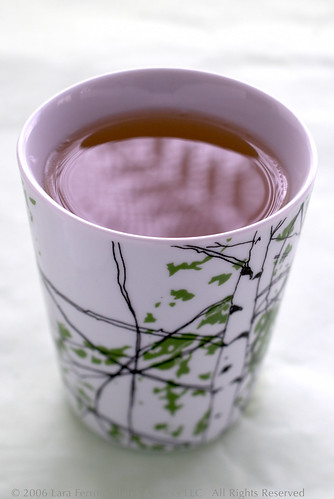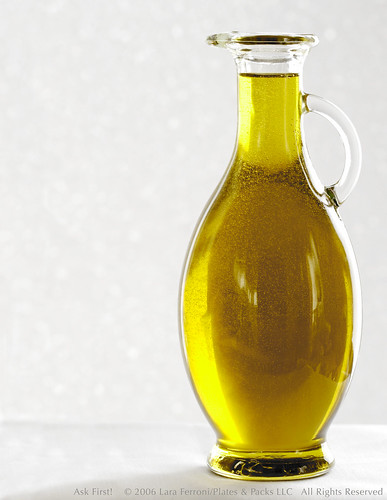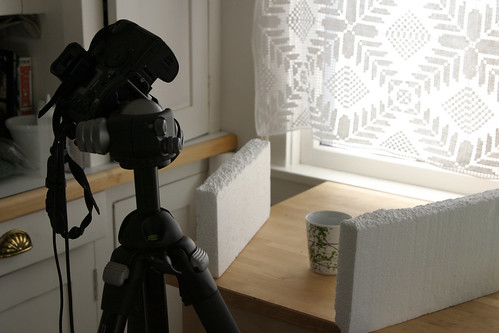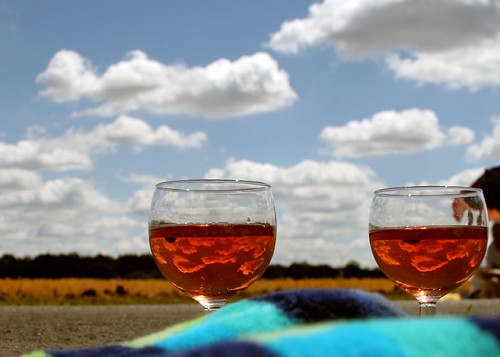Fun with reflections

One of the trickiest parts of food photography is dealing with reflections. Whether it’s shiny plates, silverware, glassware, or even the food itself, the reflection can either make the photo gorgeous or look sloppy. I often find photos of my own that I can see a tiny me and my camera captured in glint of a wine glass. It’s very hard to avoid when shooting with minimal studio equipment in a small space.

Taking control of the reflections, however, can be really fun. Pro studios do this all the time with special patterns, called gobos or cookies, that fit over lights to cast just the right shadows onto the subject to set a particular mood. There are gobos with all sorts of window-related patterns, such as blinds or french door molding, as well as more intricate designs like trees or clouds. One good book on studio lighting that I’ve found, Still Life and Special Effects, has some great examples of this complete with illustrations of where each light should be. One of my favorites shows the reflection of a magazine article in a spoonful of liquid called You should know it’s good for you (pg 206).

“Still Life and Special Effects Photography: A Guide to Professional Lighting Techniques”
(Roger Hicks, Frances Schultz)
But, even if you aren’t using studio lighting, you can do some interesting things with reflections. It just takes a little planning and a little playing.
First, figure out what pattern you want. For the tea shot above, I used a crocheted table cloth with leaf-like patterns that I picked up at a thrift shop. But, you can use paper cut outs or even a plant to cast interesting shadows. Flat patterns are easier to manipulate though, especially if you don’t really want the shadow-caster to show up in your shot.

Next, you’ll need to position your pattern between the reflective subject and the strongest light source (like a window). Then, you’ll need to take a few shots at the angle of the final shot you want. Because you won’t want the pattern to show up in your image, you probably want to shoot from above your subject or fairly close in. Getting the shadows to fall just where you want them will probably require a bit of moving both the subject and the pattern around, so having a tripod makes this whole process considerably easier. Getting proper exposure is also important so that the shadows stand out, without being overwhelming or harsh… a little exposure adjustment in Photoshop later can usually compensate if you don’t get it quite right in the camera.

Of course, sometimes you end up with great reflection shots that are completely unintentional, like this photo that I took at a roadside picnic in France. I was focused on the wine glasses and capturing that roadside feel, and completely missed the cloud reflections until looking at the photo later.
Technorati Tags: Food, Photography, Tips
I often capture a tiny me too! The book looks great – I’m adding it to my wishlist. Thanks for the tips!
A great photo and a wonderful tip. I used my covered porch quite a bit, but find the fan blades show up in spoons sometimes.
The only time I have ever managed a reflection that I thought enhanced the photo was in the back of the spoon in my top photo for my peach, ginger, cornbread trifle. It was completely by accident, and I haven’t really thought about using reflections since. Your post reminds me of how great an idea that is.
I love the photos you have here. The top photo and the wineglass one are incredible. Looking at the top photo, it’s so subtle that I feel like I’ve discovered a beautiful secret by seeing the pattern reflected on the liquid. The clouds in the wine are simply breathtaking.
Thank you so much for this.
Not something I have ever considered in great depth are reflections, especially as a postive attibution to an image. SO thanks for the inspiring post.
The book has been added to my Amazon Christmas wish list!
Great post, thnx for showing your shot of your shoot. What ISO and lens did you use?
Nika
Love the clouds in the wine glasses. They look so fanciful, almost unreal!
Thanks Catherine. Sometimes, when I know I’m just going to live with the reflection of me, I ham it up and wave or stick out my tongue!
Lynne – yes, my studio is a tiny nook too. It helps that it happens to be all white though.
Nice photo Danielle! It makes the trifle look absolutely towering.
Andrew – you are certainly welcome!
Nika – the teacup shot was using a 45mm Tilt-shift that I’m borrowing from a friend (it’s so nice to have friends with nice lenses!). Unless I’m in a condition that I can’t control the light, I always shoot at ISO100 so there is less noise in the image. Thanks!
Jennifer – Thank you!
As always, great insights and information. On the book front, I just discovered a fascinating one: “Working the plate: the art of food presentation” by Christopher Styler and photographer David Lazarus.
The author has been a chef and a food stylist for magazines as well as a food writer. All the tricks used for professional food photography that had nothing to do with the food itself often frustrated him; this book is about quickly and beautifully plating real food as it comes from the pan. He enlists the help of ten different chefs to showcase seven very different approaches to plating.
My only issue with this wonderfully informative book is that it only contains a handful of the recipes it shows. Still, many great ideas for both chefs and photographers.
Great shots. Thank you for giving us the “setup” shot as well. I find that I can learn positioning techniques through that means.
Did you photoshop the white background on the teacup or did you use a tablecloth?
I, too, love the clouds in the wineglasses. They imply somehow that you’ll be flat on your back, skygazing, soon.